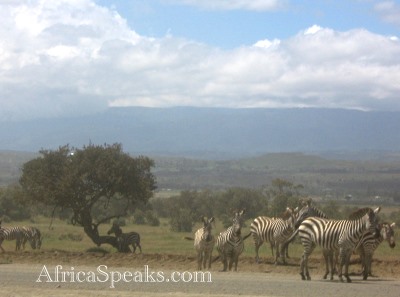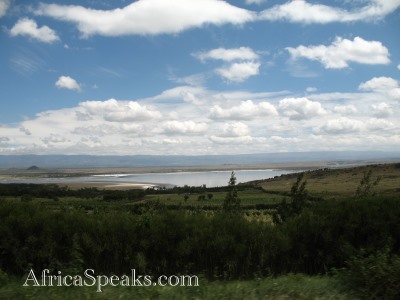
UWI Students Trip to Kenya
Date: Saturday, July 29 @ 16:34:35 UTC
Topic: Africa
Africa - The Continent of Beginnings
By Ras Tyehimba
Eighteen of us from the University of the West Indies set out for Africa, the continent of beginnings, to spend a month in Kenya. Why Africa? For us in the Caribbean most of our interests and our relationships with people and institutions have traditionally been focused in the direction of Europe and the United States. These countries wield great influence in terms of the tastes, attitudes, and way of life of Caribbean people. Going to the Unites States and Europe to visit, work, shop or to be ‘educated’ is greatly valued. In reference to Africa, the land from which the ancestors of the majority of the Caribbean people were taken away in chains, there continues to be a lot of distortions and omissions about the history of African people, their day to day reality and the significance of Africa within the global capitalist system.
 Ras Tyehimba overlooking the Kenyan National Archives Ras Tyehimba overlooking the Kenyan National Archives
Information about the world has come from sources that can best be described as being suspect. There is too much reliance on Hollywood, CNN and BBC to tell a story that they cannot tell. It is misleading to watch Hotel Rwanda, A Day in April and Black Hawk Down and think that one is informed about the situations there. It is against all these influences that we journeyed to the continent of beginnings, where humanity started millions of years ago, to build direct links with a continent whose history and people has been sidelined on the world stage; a continent where our ancestors were brutally taken from centuries ago.
We took a plane from Tobago to London, from London to Dubai, from Dubai to Nairobi, the capital city of Kenya; 21 hours of flying. During the long flight I had a lot of time to think about the relationship between the African Diaspora in the Caribbean and elsewhere and the African continent. How much easier it would be if there were direct flights from the Caribbean to Africa. There has long been talk of doing this, it has never materialised. Direct flights would not only allow for trading links to be established but it would broaden the context of interaction between the African Continent and the Caribbean.
We landed first in Gatwick Airport in London, after the 9 hour flight. Gatwick was huge and extravagant; with some stores having multiple outlets throughout the airport. We landed in the airport in Nairobi after a five hour flight from Dubai, the capital of the United Arab Emirates. Nairobi is Kenya’s biggest city and has all the trappings of a modern city. Tall buildings fill the landscape and massive advertising billboards are everywhere. The climate was warm and sunny, though not as hot as in the Caribbean.
 Zebras Zebras
Just arriving in Kenya gave me a good feeling. Kenya - the land of the Mau Mau, Jomo Kenyatta, Elijah Masinde and countless unnamed heroes and heroines who struggled for freedom. Kenya is on the east coast of Africa, bounded by Somalia and Ethiopia at the top, Uganda to the West, and Tanzania to the south. The group of 18 of us plus our host, Mr Malaho from the Kenya Volunteer Development Services (KVDS), travelled westward for 9 hours towards Bungoma. The dominance of agriculture became apparent as we moved from the city of Nairobi through the countryside to Bungoma. Miles and miles of corn, a main staple in the Kenyan diet were a common sight. We passed many male Kenyans tending to cattle. At times man-made water holes provide much needed water to the cattle and other animals that gather for water. We passed many zebras grazing quietly in protected private areas, cordoned off by wire fences. The scenery was absolutely breathtaking.
Driving through a dust part of the road, some monkeys ran suddenly across the road about 30 metres in front of us. The road worsened, with big potholes that the driver skilfully manoeuvred around. We passed a sign announcing that we were passing over the Equator. The vegetation around the equator was particularly lush, the soil, dark, moist and apparently fertile.
We entered the famous Rift Valley region with the road leading us upwards .The Rift Valley is a geological phenomenon that occurred about 20 million years ago when the earth's crust weakened and tore itself apart creating a jagged rift, thousands of kilometers long, across the African continent. The land on either side erupted creating great volcanic mountains, while the valley floor gradually sank into a low flat plain. As we reached the top of the crest on one side of the Rift Valley we could see before us a wide spectacular view of the valley down below. Some areas were lush and green while others were dry and brown. Volcanic mountains towered in the distance. Some Masai traders had booths selling various exquisite craftwork. They approached, eager to sell us their items.
 Lake Naivasha Lake Naivasha
We passed several grand lakes in the Rift Valley region including Lake Naivaisha and Lake Nakuru. The other lakes are Lake Baringo, Lake Bogoria, Lake Elementaita, and Lake Magadi. The Rift Valley is home to thirty active and semi-active volcanoes and many hot springs. We had a destination to reach so there was no time to explore these places intimately, so we were content just to experience the breathtaking view of the lakes from a distance.
We stopped to get something to eat and I got my first taste of Kenyan food. Ugali is a dish that is the same texture as coo coo but it is white and made from corn. Chipati is made from flour and it is halfway between a roti and a fry bake. There are samosas as well as somawheat which resemble spinach. There are also various meat dishes including tilapia fish.
We arrived at our location in Bungoma just after nightfall. Bungoma is a rural area, home to the Bukusu people. The Bukusu people are famous for the resistance against the British colonialists. This resistance occurred long before the Mau Mau uprising and the history is told in school books. In the 1890’s they strongly resisted British incursions into their territory, but the British, using an early machine gun, massacred hundreds of brave Bukusu warriors. Then in the 1940’s and 50’s under the leadership of Elijah Masinde, a traditional medicine man, the Bukusu people rose up again and demanded the return of their land. Masinde was eventually captured and imprisoned and only released when Kenya gained independence in 1963.
Many of the people of Bungoma depend on agriculture as a means of livelihood. They grow millet, cassava, maize, beans and cabbage and raise cattle, goats and chickens. Agriculture is the backbone of the Kenyan economy, along with tourism.
 Bukusu woman collects water Bukusu woman collects water
There are about 42 different indigenous peoples in Kenya, including the Kikuyu, Luo, Luhya, Bukusu, Maasai, Akamba and Meru. Kiswahili and English are the two national languages but many people speak not just English and Kiswahili, but also their mother tongue or tribal language. Kiswhalili is a beautiful language, and I am far more motivated to learn it than I had ever been to learn French or Spanish. It is spoken most in informal settings, while English is used a lot in business advertisements and in secondary schools and universities. English is the language brought by European colonisers and as such has greater status and respectability associated with it than the indigenous languages. It is the language of the mainstream and of western styled progress.
Matatus (small buses) and bicycles are important means of transportation for ordinary Kenyans. Bicycles are everywhere, most of them are bicycle taxis having a small seat at the back for the passenger to sit. Bungoma is very different to the main city Nairobi; people are more traditional in Bungoma especially in terms of language and dress. More people dress in traditional African materials and women frequently have their heads tied.
It is customary to see two male Kenyans walking down the street holding hands and talking, or walking with one hand around the others shoulder. This is simply how friends may relate to one another and it does not connotate homosexuality.
The Kenyan people that we interacted with were generally very friendly and hospitable. From the way we spoke and dressed it was obvious that we were not from Kenya and many people were curious to know where we came from. Jamaica, some of them asked observing that a couple of us had dreadlocks. We told them that we came from the Caribbean from a country called Trinidad and Tobago, and had come to visit the continent from which our ancestors were taken. This explanation of our historical linkage to Africa would play an important role in our interactions with the Kenyan people, especially during our many visits to Kenyan schools and self-help groups.
To be continued ...
Our Trip to Kenya, in Pictures
|
|